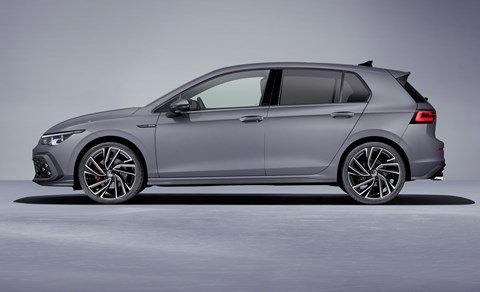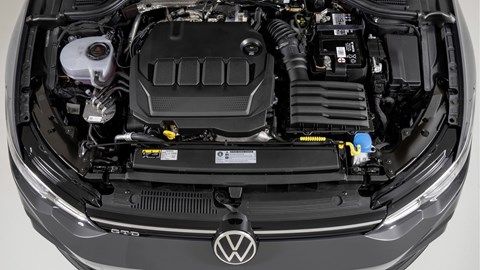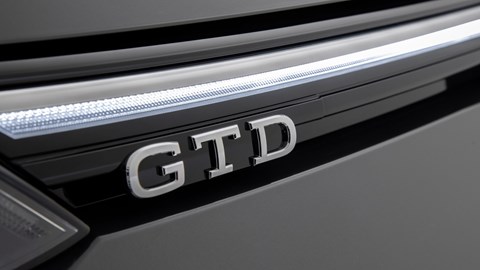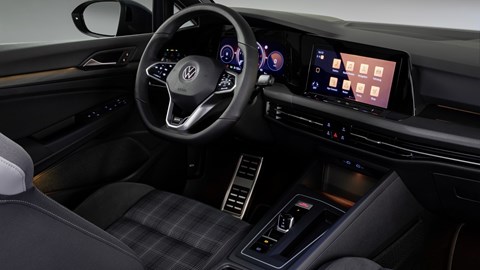► Long-range, long-distance diesel version of iconic GTI
► Much noise made about twin-dosing exhaust emissions system
► Similar look to GTI and GTE siblings
The thinking man’s GTI? Volkswagen’s revealed the first full pictures and details of its new Golf GTD – based on the 2020 Golf 8, and taking up its spot as the most powerful diesel model in the range.
It’s been revealed alongside the 2020 Golf GTI and GTE, and all three of these performance models will go on display to the public at the Geneva motor show in March 2020.
Isn’t diesel a dirty word?
At VW? Rather. The company’s dieselgate era is likely to remain hanging over it for plenty of time yet – but it doesn’t seem to have harmed ambition. Indeed, VW’s jumped into this GTD model with both feet, proclaiming it to have ‘one of the cleanest combustion engines in the world’ – not just one of the cleanest diesels.

That’s thanks mainly to a twin-dosing system for the exhaust emissions control systems. There’s two catalytic converters and two Adblue dosing points. Confusing? Definitely. Fragile? Possibly. We’re certainly not going to recommend this as a town car, as systems like this need plenty of long runs at high speed to keep operating effectively.
Should I buy a diesel car?
Think of the GTD, then, as a long-distance tourer with sporting ambitions, rather than an out-and-out hot hatchback like its GTI sibling.
How powerful is the diesel?
VW’s 2.0-litre EA288 evo engine generates 197bhp and an impressively chunky 295lb ft. A manual is off the table – not enough people purchased the previous-generation, apparently – so your only option here is VW’s seven-speed DSG, controlled via a drive-by-wire selector in the centre console or paddles behind the wheel.

Performance and economy figures haven’t been revealed yet, but we’ll update this page when they are. However, it’s more than a fair assumption to suggest the GTD will be slower than the GTI – but vastly more efficient, in keeping with its ‘long-distance sports car’ ethos.
Does it look any different to the GTI?
The same styling pack is applied to all three GT cars – consisting of coloured highlights, a subtle body kit, tartan seats and larger alloy wheels. However, where the GTI’s highlights and pinstriping are red, the GTD’s are silver, pushing it even further under the radar than its already subtle siblings.

That continues on the steering wheel and in the tartan upholstery, where red checks are replaced with light grey ones.
Customers wishing to stay properly stealthy would do best to avoid optioning the lighting package for the front end. Consisting of a full-width LED element across the grille as well as honeycombed foglights, it’s a slick and distinctive look that will mark performance VWs out from the crowd.
What’s the interior like?
The GTD gets Volkswagen’s latest Innovision infotainment system – a pairing of 10.25-inch Virtual Cockpit and 10.0-inch infotainment display, fitted with the latest connected systems, smartphone links and smart 3D nav. Admittedly, it’s an option, but it’s one worth ticking. While the digital dials come as standard, only GTE cars get the larger central screen – GTI and GTDs come fitted with an 8.5-inch unit instead, which is rather less striking.

Elsewhere, it’s business as usual. Volkswagen’s war against the physical button is most stark in the interior of the Golf 8 – there’s just one, for the hazard lights. Ambient lighting is ample, and there’s an air of solidity that many rivals struggle to match.
Who is this car for?
It’s for the boy racer who’s grown up and now has an hour’s motorway commute each day. Volkswagen will no doubt claim the GTD has all the character of the GTI – and while that’s the case in terms of suspension components, chassis tuning and physical appearance, we’re not expecting it to be anywhere near as engaging.
And that’s fine. While the GTI will make light of the twisty bits at either end of a commute, the GTD is much more likely to relax on the big chunk of A-road in the middle. It’s a sensible, efficient and rapid long-distance commuter that can occasionally enjoy being chucked around a twisty lane.
Rivals typically come from within the VW Group – top-spec examples of the SEAT Leon, for example, or Skoda’s popular Octavia vRS diesel. Besides that, diesels that combine high performance with capable chassis are few and far between, usually erring on the side of comfort.
Sounds good. When can I have one?
Order books will open soon for deliveries towards the end of 2020. Expect prices to increase somewhat over its predecessors initial £26,300 – if only due to the lack of a basic 3dr, manual model. We’ll bring you more details, including performance and fuel economy stats, as soon as we have them.